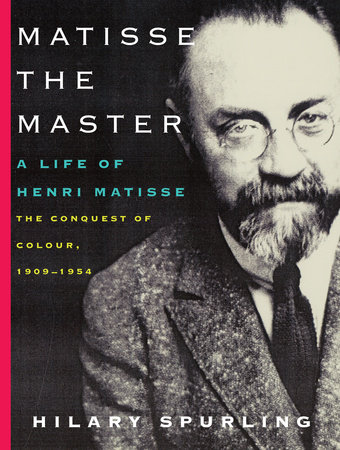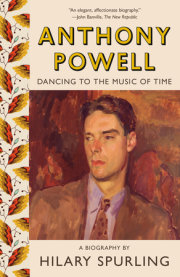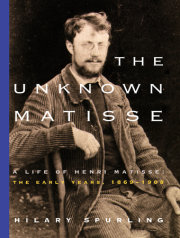1909: Paris, Cassis and CavalièreReturning from Berlin to Paris in January 1909, Henri Matisse got off the train partway to visit one of his few German supporters. He had just said good-bye to his majestic Harmony in Red, leaving it behind in a gallery in Berlin, where people said his latest paintings were senseless, shameless, infantile monstrosities or sick and dangerous messages from a madhouse. The French felt much the same. Harmony—the goal Matisse desired more passionately than any other—was the last thing his art conveyed to his contemporaries.
His host at Hagen, a few miles along the Ruhr from Essen, was the collector Karl Ernst Osthaus, who had already bought five works from Matisse and was about to commission a sixth. Osthaus insisted on showing off his latest acquisition, a mosaic design installed in a modern crematorium newly built on an industrial waste site. When they entered the building on a cold, grey, rainy Sunday afternoon they found an organ playing softly in the gloom and a coffin sinking into the ground in front of them. Tired, depressed and deeply shaken by what had happened in Berlin, Matisse lost his usual composure and let out a scream: “My God, a dead body!”
Osthaus explained that the body was a fake, part of a public relations exercise put on to counter the local workers’ instinctive mistrust of cremation. But Matisse could not forget it, and often marvelled afterwards at the strange way Germans chose to amuse them on a Sunday afternoon. He had a second shock when he got home and received a parcel from Germany containing what looked like a gigantic funeral wreath. In fact, it was a wreath of bays posted by a young American admirer, Thomas Whittemore of Tufts College, to console Matisse for the failure of his Berlin show. Trying to lighten her husband’s nervous tension, Mme Matisse tasted a bay leaf (“Think how good it will be in soup”), and said brightly that the wreath’s red bow would make a hair ribbon for their fourteen-year-old daughter, Marguerite. “But I’m not dead yet,” Matisse said grimly.
The work Matisse stopped off to see in Hagen was his own Nymph and Satyr. It was a relatively conventional set of three ceramic panels showing a stocky muscular nymph doing a stamping dance, then falling asleep and being tentatively approached by a hairy, hopeful satyr enclosed in a frieze of grapes and vine leaves. In January 1909, Matisse had recently completed an oil painting of the same subject (colour fig. 1). This time the satyr (who had been more of a tame faun on Osthaus’s glazed tiles) started out with a little beard and pointy ears, but turned into something far more violent and raw. Matisse’s final version is unequivocally human: a clumsy, graceless, lustful male advancing purposefully on a naked female huddled with her back turned at his feet. The man’s pink, thinly painted flesh is outlined in red, the colour of arousal. So is the woman’s, but every line of her expressive body—bent head, drooping breasts, collapsing limbs—suggests exhaustion, helpless weakness and enforced surrender.
This is the mood of Paul Cézanne’s The Abduction (or The Rape), where another masterful naked man carries off another pale, limp, fleshy female. The fierce erotic charge in both paintings is reinforced by harsh colour and rough handling. In Matisse’s case, the texture of the paint was itself an outrage. The choppy stabbing brushstrokes, the landscape’s crude contours filled with flat scrubby green, the blurry patches round the man’s head, crotch, left hand and right knee, all convey extreme disturbance. His picture, like Cézanne’s, is both personal and symbolic. Both suggest an image spurting up from some deep, probably unconscious level of the imagination on a tide of bitterness and rage. Matisse’s satyr looks as if he means to strangle his victim with his outsize red hands. Matisse himself said that this was how he always felt before he began a painting.
For him each painting was a rape. “Whose rape?” he asked, startling his questioner (perhaps also himself) with the brutal image that surfaced in his mind during an interview that took place more than three decades after he painted Nymph and Satyr: “A rape of myself, of a certain tenderness or weakening in face of a sympathetic object.” He seems to have meant that he relied on his female models to arouse feelings that he could convert to fuel the work in hand. He confronted whatever underlay that process head on in Nymph and Satyr. The displaced emotion here is at least in part aesthetic. The last time Matisse put classical nymphs into a picture was in 1904 in Luxe, calme ET volupté, an uneasy experimental composition that led directly to the explosive canvases dismissed by most people the year after as the work of a wild beast, or Fauve. In the winter of 1908–9, Matisse was once again grappling with, and violating, the ancient canons of a debased classical tradition in a canvas that commits pictorial and depicts sexual rape.
This coarse, powerful, primitive painting was earmarked for the Russian collector Sergei Ivanovich Shchukin, a man in process of committing himself as unreservedly as Matisse to liberating painting from the academic tyranny of Beaux-Arts aesthetics. Shchukin was an inordinately successful textile manufacturer with a patchy education and no academic training. People dismissed him, in both Paris and Moscow, as gullible and uncouth, an ignorant boyar who made no attempt to cultivate the refinement that enabled other Moscow merchants to build up more serious art collections. It was Shchukin who had commissioned the Harmony in Red currently hanging in Paul Cassirer’s gallery in Berlin. Shchukin came to see it there and, unlike the German art world, was powerfully impressed. On 9 January he followed Matisse to Paris to inspect work in hand in the studio, including the Nymph and Satyr.
Shchukin took delivery of six Matisse paintings in the month after he got back to Moscow. The painter said that in some ways he came to dread the visits of this particular collector because of his unerring knack for picking out the latest breakthrough canvas and carrying it off, sometimes with the paint still wet. Shchukin grasped at once that Nymph and Satyr was an affront to decency and morals, which only increased his impatience to possess it. This new canvas could not easily be displayed in mixed company, let alone in public. It was quite different from the sexy pictures other men kept behind locked doors in their private rooms and cabinets. Its secret kick for a subversive like Shchukin was precisely that it violated every sacred Beaux-Arts precept enshrined in the flawless public nudes that filled the Paris salons.
The contemporary French incarnation of those precepts in the eyes of fashionable Moscow was Maurice Denis. Shchukin himself owned several pictures by Denis, who had once embodied the last word in sophistication for him, too. In January 1909, Denis was making waves in Moscow. He had come to install his latest work in the home of another Moscow merchant, Ivan Abramovich Morozov (who had also made a fortune out of textiles). Morozov, who was Shchukin’s close friend and only Russian rival in the field of modern art, had ordered seven huge painted panels telling the story of Cupid and Psyche for his music room.
Denis pictured Cupid as a plump, life-size, naked youth wearing wings to match his predominant colour scheme of pink, green and blue. His Psyche is a solid girl with cushiony breasts, buttocks and hips. The couple’s sturdy build adds to the absurdity of their chaste embrace as they dangle cheek to cheek in midair with nothing touching below the waist. The décor of Cupid’s palace with its garden ornaments, mauve silk drapes and floral sprays is more reminiscent of an expensive modern florist than of ancient Greece. This is seduction with any hint of desire or danger airbrushed out. It went down well on its first showing at the Paris Autumn Salon, and it made an even bigger splash in Moscow. So much so that Morozov, who was thinking of hiring Matisse to decorate his dining room, dropped the idea in favour of commissioning six more panels from Denis.
It was Shchukin instead who commissioned wall paintings from Matisse. The painter never forgot the lunch at the Restaurant Larue in Paris where the pair of them together hatched a plan to end all blue-pink-and-green decorative schemes peopled with dancing nymphs and piping fauns. Matisse’s Dance and Music grew from their conversation at this lunch. “I hope that when they see your decorations, the tumult of admiring cries to be heard at present will die down a little,” Shchukin wrote in May, describing the fuss over Denis’s Psyche. “At present they talk of it as a great masterpiece. They laugh at me a little, but I always say, ‘He who laughs last, laughs best.’ I trust you always.”
Nymph and Satyr, one of the starting points for the new scheme, was finished, crated up and posted off to Moscow in early February. By this time, Matisse had left Paris for the Mediterranean coast. He planned to spend a month at the little Hotel Cendrillon in Cassis, replenishing the stocks of energy depleted by the gloom and strain of a Parisian winter. Walking along the steeply shelving shore at Cassis and in the chestnut woods on the cliff top, he studied air, water, light, sun glinting on spray, waves pounding on rocks as he had done further along the coast at Collioure four years earlier. “There is . . . a cove near Cassis,” wrote Marcel Sembat, who spent a day with Matisse in early March, “where the green of the open sea on the horizon brings out the deep blues and foamy whites of the tide trapped between cliffs, which you can see jostling and throwing up little blade-like crests in the full sun.”
Movement preoccupied the painter in the run-up to the Dance. Sembat was struck by the intensity and accuracy of Matisse’s response to the violent swirling currents, “the clash of creative contrasts we talked about together.” Sembat, seven years older than Matisse, married to a painter and himself a passionate art enthusiast, was an exceptionally acute and attentive witness. By his own account he was living out a dream that day in Cassis, having brought with him one of his lifelong heroes, the great reforming architect of the Third Republic, Jean Jaurès. The Socialist leader and his two companions walked and talked beside the sea, delighted with one another, with the brilliant spring sunshine, and with the infectious visual excitement emanating from Matisse at the end of his month in the country. They rounded off their morning over lunch at the hospitable little village inn. Sembat wrote the day up in his diary and returned to it again a decade later, leaving no doubt that, for him at least, there was something magical about this unlikely encounter between two great French stars, one rising fast, the other soon due to set forever.
Sembat’s writings provide some of the sharpest and most lucid testimony to Matisse’s progress in the decade leading up to the First World War. The two first met, probably, through Georgette Agutte, Sembat’s wife, who had belonged loosely to the same little knot of painters as Matisse in their student days. But they had an even earlier point of contact through Matisse’s wife, Amélie, whose father, Armand Parayre, knew Sembat from the start of his career. As a newly elected Socialist deputy writing leaders for Parayre’s radical campaigning newspaper, Sembat had belonged to the generation of up-and-coming Republican politicians who, unlike many of their elders, managed to leap clear of the sensational Humbert scandal which all but destroyed Matisse’s in-laws in 1902. Parayre himself survived public ignominy, imprisonment and a dramatic trial with the help of his young son-in-law (this was the first if not the last time Matisse had reason to be thankful for the brief training as a lawyer forced on him by his own father).
Amélie Matisse emerged, like her father, apparently unscathed from her family’s terrifying ordeal. (Her mother, who never got over it, died prematurely in 1908.) But the affair left Amélie with a deep-seated horror of any kind of exposure, and a lasting suspicion of the outside world. It reinforced her self-reliance, her stubborn pride and her almost reckless indifference to what other people thought. Beneath the demure and unassertive manner that was all she showed to those who didn’t know her, Amélie was, by the standards of her class and age, profoundly unconventional. Her marriage had been a gamble in which money, security, and social advantage played no part. She became her husband’s eager partner in a high-risk enterprise neither ever truly doubted would one day succeed. She had recognised what was in him at sight, and backed her instinct unreservedly ever after.
At times, when Matisse found himself disowned not only by the professional art world but by most of his fellow artists too, his wife remained virtually his only backer. Mutual trust was the core of their relationship. “The basis of our happiness . . . was that we built up this confidence quite naturally from the first day,” Amélie wrote long afterwards to Marguerite. “It has been for us the greatest good and the envy of all our friends, it meant we could get through the worst of times.” The two did everything together. Almost from the day they met, they were known as the Inseparables. The four weeks Henri spent in Cassis was probably the longest time they had been parted since their marriage eleven years before. The studio was the centre of their world, and it was her province as much as his. Henri and his painting gave Amélie’s life its shape and meaning. Hardship and privation hardly mattered by comparison; nor did the rising tide of mockery and abuse that accompanied Matisse’s growing fame.
Even the arrival of their children hadn’t greatly changed their way of life. When it came to a choice, work took precedence over child care. Their elder son, Jean, grew up as much at home with his Matisse grandparents in the north of France as with his parents in Paris. The younger boy, Pierre, spent so much time in the south with his Parayre grandfather and Amélie’s only sister, Berthe, that his aunt became his second mother. Amélie herself was closer to the boys’ older half sister, Marguerite (or Margot), who was Henri’s child by an earlier liaison, and who became in some ways a second self to her adoptive mother. It was Marguerite who stayed at home, sharing the life of the studio that meant life itself to the Matisses.
The family dynamics began to shift a little when they finally moved out of Henri’s cramped bachelor flat in a block opposite Notre Dame into a disused convent at 33 boulevard des Invalides on the far side of Montparnasse. Money was still tight.
Copyright © 2005 by Hilary Spurling. All rights reserved. No part of this excerpt may be reproduced or reprinted without permission in writing from the publisher.









